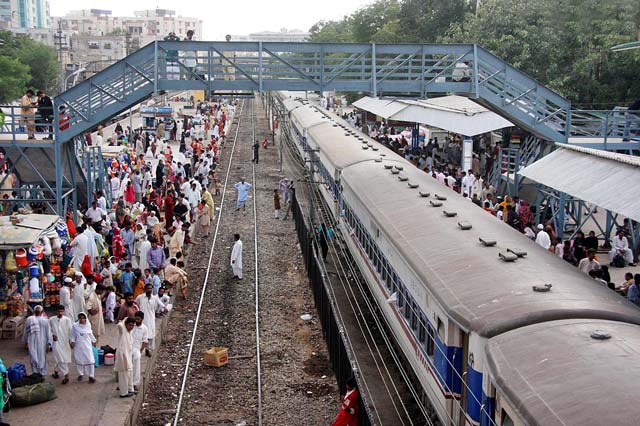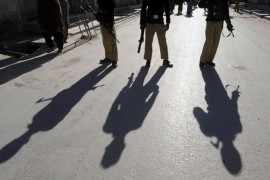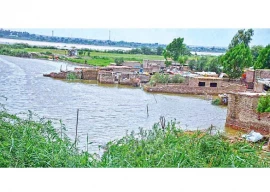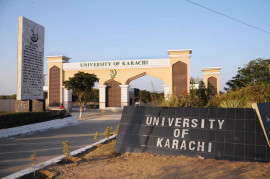
It is almost jokingly ironic that this city had circular railways, well-functioning trams and proper buses decades back whereas now it craves for a proper mass transport system.
It is not difficult to realise that the needless traffic jams that have become this city’s identification mark are a waste of resources and mental and emotional energy. A car with a seating capacity of four individuals is generally occupied by a single pitiful dweller. Every individual nowadays is compelled to have a four seater car of their own. It is not difficult to see the economic inefficiency lurking and looming out of this gloomy picture. Apart from this, the traffic jams are a source of emotional misery. They are energy vampires.
The anti-poor bias of Karachi Circular Railway's revival plan
A mass transit transport system in this case should be one of topmost priorities for this city and reviving KCR is the need of the hour. The inhabitants of the city were very happy when the project was included and enlisted in the projects associated with the China-Pakistan Economic Corridor (CPEC). However, recent reports in the media have hinted that the project is facing numerous hurdles on its way. So let’s once again reiterate the benefits that this project can bring in.
The benefits
Keeping in view the magnanimous size of every day travelers in Karachi, it can be easily imagined that this project will save millions of tons of gasoline. Hence this project must be considered as a supply side policy intervention to correct the current account deficit in the long term. If Karachi possesses 10% of the country’s population, it is safe and prudent to assume that the city consumes at least 10% of the country’s gasoline. Hence if this is the case, it can be proposed that this project could be a precious source of saving import dollars which will ease out the dollar deficit.
Furthermore, if 10% of the country’s population lives here and the city is also the economic hub, it is again not very difficult to imagine that the man hours saved through an efficient mass transit system could give a noticeable boost to the country’s GDP. Thus, such projects can play a vital and critical role in greasing the wheels of sustainable economic growth in the country.
Another ballooning problem that the city is facing is the improper construction of portions and incorrect housing arrangements in the city. People are compelled to stay in old neighborhoods i.e. Nazimabad and Liaquatabad. This is because if they settle in far flung settlements, it will be extremely draining for them to reach their places of work while the population in these areas is growing exponentially. Since the city is devoid of a proper transport system that may carry the mass exodus from new settlements, people are building and purchasing portions of small houses in these old neighborhoods.
Sindh, Railways’ dispute continues over Karachi Circular Railway section
Karachi Circular Railway and its possible extensions can provide a solution to the above problem as well.
Apart from the above two critical advantages, there are numerous other benefits that such projects can bring in. Such projects reduce pollution and increase the efficiency of human resource as they keep them energized and emotionally charged.
In this regard the policymakers do not have to re-invent the wheel. They just need to put in place a system that was functional decades back. Unlike the green line bus service and other such projects which also have many positives, this project will cover almost all populous neighborhoods of the city. People of Lyari, Nazimabad, Liaqutabad, Gulshan, Gulistan-e-Jauhar, Shah Faisal Colony and adjoining areas of Shahrah-e-Faisal will be the ultimate beneficiaries.
Although railway is generally operated as a natural monopoly and it is generally thought to be feasible when run by the government, important lessons can be learnt from the privately run intra-city railways of Japan which have done a wonderful job for so many decades. The private sector can also help in reducing the misery of the people of the city by replicating the Japanese model.
To conclude, it must be reiterated that projects like KCR have so many positive externalities and immense benefits. Certainly there are challenges but a cost and benefit analysis helps us in understanding the fact that this project must be given a priority.
The author is a corporate banker and teaches economics
Published in The Express Tribune, March 26th, 2018.
Like Business on Facebook, follow @TribuneBiz on Twitter to stay informed and join in the conversation.

















COMMENTS (4)
Comments are moderated and generally will be posted if they are on-topic and not abusive.
For more information, please see our Comments FAQ